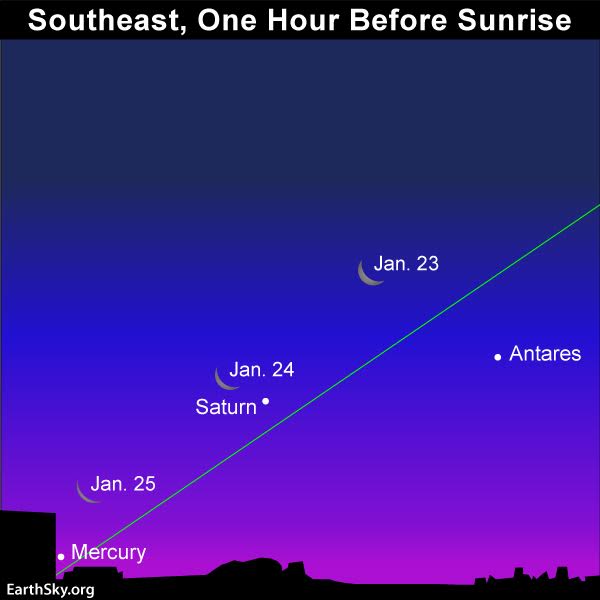The moon has been moving toward the sunrise in the past few days, and tomorrow morning – January 24, 2017 – you’ll find the moon closely paired with the ringed planet Saturn before dawn. Look first for the waning crescent moon and then look nearby for what appears to be a bright star. It isn’t a star. It’s Saturn, the most distant world that you can easily see with the unaided eye.
Got ’em? Now don’t be surprised if you spot Mercury, too! Take a look at the chart below.

The brightest morning planet, the king planet Jupiter, is also out from midnight until dawn. From mid-northern latitudes, Jupiter is found in the southern sky at dawn; and from the Southern Hemisphere, Jupiter is close to overhead before sunrise.
The star near Jupiter is Spica, brightest star in the constellation Virgo the Maiden.

Now back to Saturn, which reaches a big milestone in 2017. The northern side of Saturn’s rings will maximally tilt toward Earth in October of this year. Around that time, we’ll have the most open view of Saturn’s rings we’ve had since 2003, when the southern side of Saturn’s rings was most open. Saturn’s orbit around the sun takes about 29.5 years. Because Saturn’s orbit isn’t perfectly circular, the north side of Saturn’s rings is illuminated for a period of about 15 years and 9 months; whereas the southern side is lit for a period of about 13 years and 9 months.
You need a telescope to see Saturn’s rings, of course, but a small, backyard variety is quite sufficient. Taking into account the various conditions required to observe them, it seems that 2017 will present the very best view of the north side of Saturn’s rings since 1988, and the next time won’t be until 2046.
We list the dates on which Saturn’s rings open up most widely during the 21st century (2001 to 2100):
2003 Apr. 07: -27o 01’
2017 Oct. 16: +26o 59’
2032 May 12: -26o 58’
2046 Nov. 15 +26o 56’
2062 Mar. 31 -27o 01’
2076 Oct. 09 +27o 00’
2091 May 04 -26o 59’*
*Source: More Mathematical Astronomy Morsels by Jean Meeus, page 295
Roughly midway between the maximum exposures of Saturn’s northern and southern rings, the rings actually appear edge-on from Earth. This last happened in the year 2009 and will next take place in 2025. Because Saturn’s rings are so very thin, they disappear from view when edge-on, sometimes for months on end.
Bottom line: The January 24, 2017 waning crescent moon will be very near Saturn. Look east before dawn. And don’t be surprised if you spot Mercury, too!












